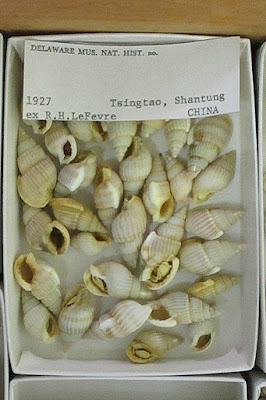kw: natural history, natural science, museums, research, collections, photographs
This week one of the museum volunteers has been putting lots into acid-fee boxes for shelving. I happened by and noticed that some of the snail shells—I didn't ask which species—had extra residents.
If you look closely at the first image, you'll see that about a third of the shells have a hermit crab showing. I pointed this out to the volunteer, who hadn't yet noticed. The collection manager, who was nearby, had an interesting story about the associations of different animals in their habitat.
He told of a paper he read that described certain crabs that were found on certain corals. The author stated that each species of crab favored certain species of coral. So the next time the collection manager was at the Smithsonian he asked to see their shelved lots of some of those species of coral. No crabs could be found! When he asked, he was told that the crabs and molted crab shells that were collected with the coral had been removed and were housed with other crabs in their own section of the museum.
The moral of the story is that the mere existence of a particular species in a particular location is not the only thing a biologist wants to know. Population ecology is about the relationships among all species in an assemblage. Thus, when a certain species is collected, the species found near, in or on it also need to be noted. In the case of the crabs and the corals, a database search for all species collected at such-and-such a location can help an ecologist re-unite them and other species from there and study the entire assemblage.
This image is a closer look at some of the shells and their residents. I see at least five hermit crabs here. It is very likely that they all are the same species. It is usually possible to determine at least the genus, if not both genus and species, of a hermit crab without pulling its remains out of the snail shell. Soon, we hope it will be not just possible, but economical, to pull a few hairs from the leg joints and use DNA analysis to determine the species of crab.


No comments:
Post a Comment